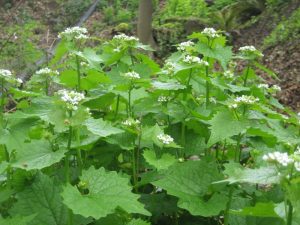Mission Possible: Eradicating Invasive Species in Cincinnati Parks
Cincinnati Parks staff and volunteers have worked on removing and eradicating invasive species in our parks for many years. Invasive species are harmful to our forests and ecosystems, and removing them is essential to ensuring wildlife thrives.
One of the invasive species currently in bloom and found throughout the parks system is garlic mustard. Volunteers and staff have already begun the hard work of scouring the ground for them and correctly pulling them out.
Garlic mustard, or Alliaria petiolata, is uncommon in its native range across Europe, Asia and Northern Africa. This is likely due to its “predators,” aka insect species that attack the stems, leaves and seeds. Here in Cincinnati there are only a few slugs, snails and flea beetles that eat a little bit of it, but not enough to keep it at bay. Did you know that in Europe, it has been a food source for many years? It is edible!
Why does it grow so thick in Cincinnati? Each plant makes hundreds of seeds. Some come up immediately and others wait in the soil up to 6 years for a chance to sprout. The plants can grow very close together, shading out everything else. Just one plant can populate an area, because the flowers can self-pollinate and make seeds without help. The seedpods shatter when touched, raining down many small seeds. Some of the small seeds will land on people and animals that are passing by and hitch a ride.
Why is it harmful? The dense stands of garlic mustard can shade out native plants. The plant secretes chemicals into the soil that slow down the growth of some other kinds of plants and it even changes the soil by keeping many soil fungi from growing.

Identifying it: The leaves have toothed edges, sunken leaf veins. Winter and early-spring leaves have purplish stems. A clump of leaves last through the winter into spring. Around April, half of the plants send up flower stalks with many small white, 4-petal flowers, followed by many thin green seedpods. Every part smells like garlicky mustard when torn or smashed.
How to kill one: Grab the long taproot as low as you can, below the leaf clump. Pull the whole root carefully up out of the ground. Uprooted plants can still bloom and make seeds, so put the plants in a plastic bag, or chop them up, or bury them deeply.
How to eradicate it: Keep killing it in the same area for multiple years until the soil has no seeds left to sprout. That’s 2 to 6 years. Then it’s gone.
- If you have the time, pull out every plant, and you’ll be done 1 year earlier.
- If you have a HUGE amount of it, you can wait until late March-early May when it is flowering and just pull the ones with flower stalks. You can find these quickly and easily. Pulling these will stop any new seeds from forming. All the plants that don’t flower this year will flower next year, and then you’ll pull them up, too. (It lives for 2 years.)
Do your part: If you want to help keep your green spaces healthy and free of invasive species, you can volunteer with Cincinnati Parks! If volunteering is difficult during this time, you can pull them out on your own, whether in your backyard or when taking a hike along one of our trails. Just make sure you are aware of best practices so that you don’t accidentally spread the plant.
We can all work together to remove and, eventually, eradicate these invasive species from our parks and green spaces. Let’s call it Mission POSSIBLE!
Jonathan Duerbeck enjoys caring for special places and showing people the wonders in our world. Fortunately, that’s his job as a Cincinnati Parks naturalist based at California Woods Nature Preserve.
